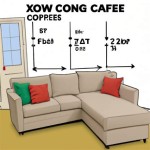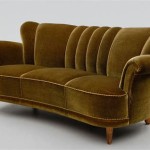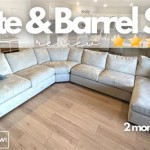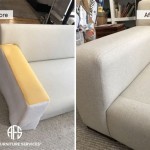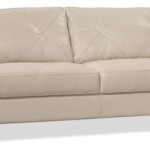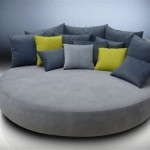What Is A Sleeper Sofa?
A sleeper sofa, also known as a sofa bed, represents a multi-functional piece of furniture designed primarily as a sofa but incorporating a hidden bed within its frame. This dual functionality makes it a popular choice for individuals and households seeking to maximize space utilization, particularly in apartments, smaller homes, guest rooms, or home offices where dedicated guest bedrooms are not available.
The core concept of a sleeper sofa revolves around a mechanism that allows the user to convert the sofa into a bed relatively easily. This mechanism typically involves unfolding or pulling out a hidden mattress and frame section from within the sofa's interior. When not in use as a bed, the mechanism is retracted and concealed, allowing the furniture to function solely as a comfortable seating area.
Understanding the construction, types, and functionalities of sleeper sofas is crucial for making an informed purchasing decision. The market offers a diverse range of sleeper sofas, each with its own set of advantages and disadvantages concerning comfort, ease of use, durability, and aesthetic appeal. These factors should be carefully considered to ensure that the chosen sleeper sofa meets the specific needs and lifestyle of the user.
Key Point 1: Types of Sleeper Sofa Mechanisms
Sleeper sofas are categorized based on the mechanism used to deploy the bed. The following are some of the most common types:
Pull-Out Sleeper Sofas: These are the most traditional type of sleeper sofa. They feature a mattress and frame that are folded and stored within the sofa's base. To convert it into a bed, the user typically removes the cushions and pulls out the concealed frame and mattress. These mechanisms are typically durable, though the comfort of the mattress can vary considerably based on its thickness and material.
Click-Clack Sleeper Sofas (Futons): These sofas convert into a bed by reclining the sofa back until it lies flat. The backrest typically features a click-clack mechanism that allows it to lock into various positions, including upright (sofa), reclined, and flat (bed). Futons generally offer a firm sleeping surface and are often more affordable than pull-out sleeper sofas. However, the comfort level can be lower compared to models with dedicated mattresses.
Convertible Sleeper Sofas (Daybeds): These sofas are designed to be stylish and serve as a comfortable seating area during the day and easily transform into a bed at night. They often have a simple design and can convert by removing cushions or adjusting the backrests, offering a more streamlined and modern look.
Sectional Sleeper Sofas: These are modular sofas that include a section containing a sleeper mechanism. Sectional sleeper sofas offer greater flexibility in terms of configuration and seating capacity. They are suitable for larger living spaces where both seating and sleeping accommodations are required. The sleeper section may utilize a pull-out mechanism or a click-clack system.
Air Mattress Sleeper Sofas: These sofas feature a built-in air mattress that inflates when needed. They often include an integrated pump for easy inflation and deflation. Air mattress sleeper sofas can provide a relatively comfortable sleeping surface, but the durability of the air mattress itself can be a concern.
Key Point 2: Factors Affecting Comfort and Durability
The comfort and durability of a sleeper sofa are significantly influenced by several factors, including the mattress quality, frame construction, and upholstery material.
Mattress Quality: The mattress is arguably the most crucial factor affecting sleeping comfort. Sleeper sofa mattresses can range from thin innerspring models to thicker memory foam or latex options. A thicker, higher-quality mattress will generally provide better support and pressure relief. When evaluating mattress quality, consider the density of the foam, the type of coils used in innerspring models, and the overall thickness of the mattress.
Frame Construction: The frame provides the structural support for the sofa and the bed mechanism. Look for frames constructed from solid wood or steel, as these materials are more durable and resistant to wear and tear. Avoid frames made from particleboard or other composite materials, as they are more prone to damage. The quality of the hinges and mechanisms used to deploy the bed is also critical. These should be robust and operate smoothly.
Upholstery Material: The upholstery material affects the sofa's appearance, comfort, and durability. Common upholstery options include fabric, leather, and synthetic materials. Fabric upholstery is generally more affordable and offers a wider range of colors and patterns. Leather is more durable and easier to clean, but it is also more expensive. Synthetic materials can offer a balance of affordability, durability, and ease of maintenance. Consider the material's resistance to stains, fading, and wear when making your selection.
Mechanism Quality: The ease of use and longevity of a sleeper sofa depend heavily on the quality of its folding or unfolding mechanism. A well-designed mechanism should operate smoothly and require minimal effort to convert the sofa into a bed and back again. Look for mechanisms with sturdy hinges, smooth gliding rails, and locking mechanisms that securely hold the bed in both the open and closed positions.
Weight Capacity: Always check the weight capacity of the sleeper sofa to ensure it can safely accommodate the intended users. Exceeding the weight limit can damage the frame or mechanism, reducing its lifespan and potentially posing a safety hazard.
Key Point 3: Considerations for Different Living Spaces
The choice of sleeper sofa should take into account the size and layout of the living space where it will be placed. Different types of sleeper sofas are better suited for different spatial configurations.
Small Apartments: In small apartments, space is at a premium. Opting for a compact sleeper sofa with a minimalistic design can help maximize the available living area. Click-clack sleeper sofas or futons are often a good choice for small spaces due to their simpler mechanisms and smaller footprint compared to traditional pull-out models. Consideration should be given to the size when opened into a bed, ensuring it doesn't block doorways or essential pathways.
Guest Rooms: Sleeper sofas in guest rooms should prioritize comfort for overnight guests. A pull-out sleeper sofa with a high-quality mattress is generally the best option for providing a comfortable sleeping experience. Consider adding extra pillows and blankets to enhance guest comfort. Sectional sleeper sofas can also work well in larger guest rooms, providing ample seating as well as a comfortable bed.
Home Offices: If the sleeper sofa will be used in a home office, consider a model that is both comfortable for seating during the day and easy to convert into a bed when needed. A convertible sleeper sofa or daybed can be a good choice for this type of space, as it offers a stylish and functional seating option that can quickly transform into a sleeping area.
Living Rooms: Living rooms often require a sleeper sofa that is both functional and aesthetically pleasing. Choose a model that complements the existing décor and provides comfortable seating for everyday use. Sectional sleeper sofas can be a good choice for larger living rooms, providing ample seating and sleeping space. Consider the overall style and color of the sofa to ensure it integrates seamlessly with the rest of the room.
Accessibility: Always consider the ease of access to the sleeper sofa when it is converted into a bed. Ensure that there is enough space around the bed to allow guests to move around comfortably. Avoid placing the sleeper sofa in a location where it will block doorways or other essential pathways when it is open.
Beyond these considerations, it is important to evaluate the sleeper sofa's ease of maintenance. Upholstery materials that are stain-resistant and easy to clean are particularly desirable, especially in households with children or pets. Regular cleaning and maintenance will help to prolong the life of the sleeper sofa and keep it looking its best.
Finally, budget is always a factor. Sleeper sofas range considerably in price, depending on the type of mechanism, the quality of the materials, and the brand. Setting a budget beforehand can help to narrow down the options and ensure that the chosen sleeper sofa meets both functional and financial requirements.

Best Sleeper Sofas 12 Couches Your Guests Won T Mind Sleeping On Time Stamped

2010mm Full Sleeper Sofa Bed With Storage Upholstered Convertible Cotton Linen Beige Homary

What Is The Difference Between A Sleeper Sofa And Bed Expresshood Com Blog

The 21 Best Sleeper Sofas Of 2024 Based On Reviews

11 Best Sleeper Sofas Sofa Beds And Pullout Couches In 2024 Top Picks

Manhattan Sleeper Sofa
Kendale Sleeper Sofa With Storage Chaise Costco

The Very Best Sleeper Sofas Tested And Reviewed By Our Editors Architectural Digest

Mjkone Twin Size Convertible Sofa Bed Modern Pull Out Linen Sleeper Couch Revesible With Cushions Throw Pillows For Small Place Apartment Living Room Office Studio Light Gray Com

Shelter Queen Sleeper Sofa 80 West Elm

